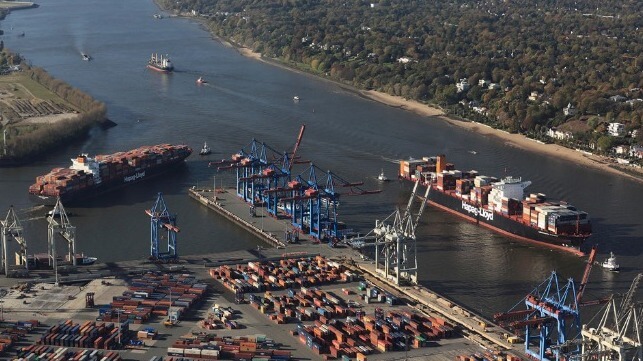Hamburg Container Throughput Declines Due to Loss of Russia Trade

Leading ports in Europe continue to be impacted by the loss of Russia-related business due to sanctions. The port of Hamburg became the latest to announce a sharp drop in container throughput for the first quarter of the year which executives linked to the trade restrictions.
Russia had been the port of Hamburg’s fourth largest trading partner up until last year and the start of the war. Having lost the portion of cargo business related to Russia, Hamburg which is Europe’s third-largest container port reported container volume declined by almost 17 percent in the first quarter of 2023. Total seaborne cargo throughput declined by 10.2 percent to stand at 28.1 million tonnes.
Axel Mattern, CEO of Port of Hamburg Marketing, said that Hamburg is feeling the extreme impact of the loss of Russian business due to its geographic position which historically made it a gateway to Eastern Europe. “Sanctions came into force after the invasion of Ukraine, as is noticeable in this comparison, freight volumes to and from Russia are now missing from the general view,” he said.
He added that apart from the Russian crisis, the fact that China is yet to fully recover from the impacts of the pandemic coupled with industrial actions in Germany have all had repercussions on the port’s performance. The port’s performance is being affected by persistent geopolitical tensions, high inflation, a decline in consumer purchasing, and overstocked warehouses that are restraining cargo handling.
Hamburg joins the ports of Rotterdam and Antwerp-Bruges, both of which have announced declines in throughput over the three-month period. The port of Rotterdam posted an 11.6 percent decline in container volume to 3.2 million TEU, a trend that started last year due to the elimination of volumes to and from Russia. Antwerp-Bruges handled 3.1 million TEU in the first quarter, a 5.7 percent drop that was led by a nearly two-thirds decline in Russia-related cargo.
Hamburg is now crafting strategies to fill the void left by the loss of the Russian cargo, with North America showing positive signs. During the quarter, the port recorded a 9.5 percent increase in U.S. business which translated to 152,000 TEU, making the U.S. the port’s second-largest trading partner after China. Trade with Canada also grew robustly at 31.7 percent to 52,000 TEU.
While container volume declined, the port recorded a 5.4 percent increase in bulk cargo to 9.3 million tonnes. Liquid cargo was the best performer, with an increase of 12.3 percent with imports of oil products rising by 27.4 percent. Growth was also recorded in agribulk with an 11.8 percent increase to 1.8 million tonnes driven by higher exports of grain and feedstuffs, along with higher imports of oleaginous fruits.
During the period, the port of Hamburg maintained the trend of large containerships calling at the facility with a 17.5 percent increase to 67 calls by containerships of the Megamax class that have a capacity of over 18,000 TEU. One of the world’s biggest Megamax containerships, the OOCL Spain with a capacity of 24,188 TEU, recently made a debut port call in Hamburg.
Going forward, the port of Hamburg is optimistic for a recovery in throughput. The German government recently approved the investment by COSCO in one of Hamburg’s terminals, a move port officials believe will help to solidify their Chinese trade and lead to additional growth.
